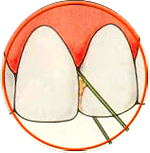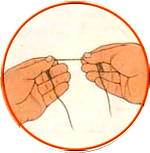


HOW LONG WILL YOUR TEETH LAST?
Your teeth are meant to last a lifetime, but they still need proper care to prevent such tooth threatening problems as decay and gum disease. Read this booklet to find out how to care for
your teeth so they stay healthy, strong, and attractive.
BACK TO BASICS
Thanks to fluoridate water and toothpastes, better nutrition, and improved dental care, Americans’ teeth are healthier than ever. But that doesn’t mean you can neglect yours. Tooth decay is still the number-one cause of all tooth loss, and gum disease is responsible for most tooth loss in adults 35 and older. The best way to prevent these and other problems is to master the basics of daily dental care, especially the proper ways to brush and floss.
BRUSHING
Brushing removes food particles and plaque from your teeth, making them look clean and freshening your breath. Brush at least twice a day with a fluoridated toothpaste that has the American Dental Association (ADA) seal of acceptance. Use a brush with soft, rounded bristles and replace it every three months. Follow these steps to clean all surfaces:




FLOSSING
Brushing does most of the work in keeping your teeth clean, but it can’t reach plaque and food particles between teeth and under the gumline. Daily flossing will keep plaque from building up in these hard-to-reach areas.
There are two types of floss: waxed and unwaxed. Use which every you prefer. To make sure you floss all your teeth, start behind the upper and lower molars at one side of your mouth and work toward the other side. Follow these steps:



Dental Dos and Don’ts
- Use fluoride. Fluoride strengthens tooth enamel and helps prevent the bacteria in plaque from causing cavities. Some drinking water is fluoridated, and toothpastes and mouthrinses with the American Dental Association seal of approval contain adequate amount of fluoride.
- Eat a balanced diet, including fruits and vegetables, careals, dairy products, and meat. Calcium is essential for strong teeth and bones. Good sources include milk, cheese, yogurt, and tofu.
- Cut back on sugary and starchy foods, which can cause tooth decay. Beware of the hidden sugars some processed foods, such as peanut butter, ketchup, canned vegetables, and nondairy creamer.
- Don’t chew on hard substances, such as ice or popcorn kernels, or grind or clench your teeth. These habits can damage tooth enamel.
- Don’t smoke or use chewing tobacco, which can stain your teeth, contribute to gum disease, or cause oral cancer.
- Don’t drink too much coffee or tea, and avoid foods that may stain your teeth.
- See your dentist at least every six months for a general checkup and professional cleaning.



